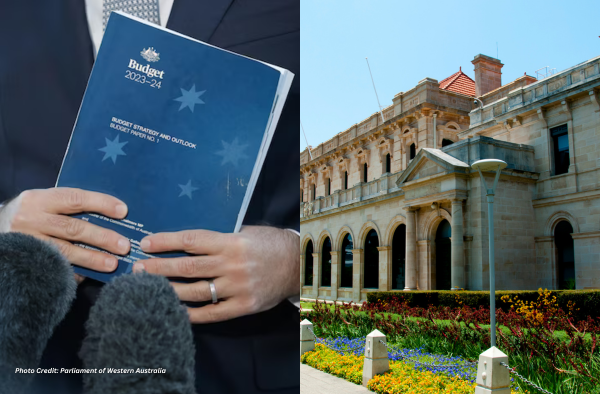Federal budget boosts local government infrastructure
Share

The Federal Budget 2024 has made significant strides in improving local governments’ infrastructure. This budget, with its strong emphasis on infrastructure development, is poised to bring about substantial enhancements in service delivery and drive economic growth. The budget clearly prioritises infrastructure by allocating significant funds to critical sectors such as transportation, energy, and climate infrastructure.
State and local governments primarily receive the funds, guaranteeing grassroots benefits. This budget reflects a significant increase in capital investment, highlighting a clear dedication to the development of infrastructure. Careful planning ensures that states with the greatest infrastructure needs receive a higher amount of funding per capita.
Enhancing infrastructure development
The Federal Budget 2024 has allocated a substantial portion of federal funds towards infrastructure projects, specifically targeting transportation, energy, and climate infrastructure. These investments aim to enhance Australia’s competitiveness, adaptability, and resilience.
- Transportation Infrastructure: The budget includes provisions for the construction and upkeep of roads, bridges, and significant infrastructure projects. This investment is projected to enhance connectivity, decrease travel times, and improve the safety and efficiency of transport networks.
- Energy Infrastructure: The budget allocates funds for the advancement of sustainable energy initiatives. This involves making investments in renewable energy sources and technologies, with the goal of decreasing Australia’s carbon footprint and encouraging energy self-sufficiency.
- Climate Infrastructure: The budget also includes funding for initiatives focused on addressing the effects of climate change. This encompasses investments in infrastructure that enhances resilience, such as flood defences and fire management systems, along with funding for research into strategies that mitigate the effects of climate change.
State and local governments distribute these investments, ensuring that the benefits of these projects reach the community level. This strategy ensures that the infrastructure development tailors to the specific needs of each region, thereby maximising the effectiveness of this funding.
Federal budget improves transport projects
The Federal Budget 2024 has allocated $7.8 billion towards significant transport projects, aiming to improve urban mobility and stimulate economic growth.
- Sydney Metro-Western Sydney Airport Line: This project is a key element of the budget’s transportation investment. The proposal includes a direct rail connection between Sydney and the new Western Sydney Airport, which would improve transportation options and reduce travel durations.
- Melbourne’s Suburban Rail Loop: This ambitious initiative seeks to connect Melbourne’s suburbs, reducing the need to travel through the city centre and improving traffic flow, resulting in shorter commute times.
- Roads to Recovery Program: Furthermore, the budget includes a substantial $2.5 billion allocation to the Roads to Recovery programme, which aims to enhance local roads throughout Australia. The goal of this initiative is to improve road safety and accessibility, particularly in regional and remote areas.
These projects are part of a larger government effort to invest in infrastructure that supports economic growth, enhances quality of life, and meets the demands of Australia’s growing urban regions. The investment highlights the government’s dedication to improving Australia’s transport infrastructure and delivering effective, dependable, and environmentally friendly transport options.
Local governments’ impact
The Federal Budget for 2024 has set aside a substantial amount of $3 billion to support local health services, with a particular focus on mental health, elderly care, and primary care facilities. The purpose of this funding is to enhance service delivery and address health disparities, particularly in underserved areas. In addition, the budget allocates funds to improve aged care facilities, ensuring they meet current standards and provide enhanced care for the elderly.
In the education sector, the budget allocates $2.7 billion to enhance school infrastructure in all regions. This investment prioritises the construction of new schools, the improvement of existing facilities, and the guarantee of quality learning environments for all students. Projects focus on constructing modern classrooms and improving technological resources in rural and regional schools, with the goal of reducing the educational disparity between urban and rural regions. The Local Roads and Community Infrastructure Programme will significantly boost environmental initiatives with $1.5 billion.
The Local Roads and Community Infrastructure Programme dedicates itself to supporting various sustainability projects, such as the installation of renewable energy sources, the implementation of efficient waste management systems, and the enhancement of local road networks. For example, funding will support the installation of solar panels on community buildings and the development of advanced recycling facilities. The focus of these projects is to promote environmental sustainability and assist local communities in reducing their carbon footprint.
Strategic funding distribution
The Federal Budget for the fiscal year 2024–25 strategically distributes funding to address infrastructure needs, with a focus on states that have lower-rated infrastructure. This allocation method ensures that states with the most significant infrastructure deficiencies receive a higher amount of funding per capita compared to states with better-rated infrastructure. The budget seeks to encourage fair and inclusive infrastructure development throughout the country by implementing this strategy, addressing inequalities, and supporting well-rounded growth in different regions.
In addition, the funding allocation aims to prioritise important sectors and regions with the goal of improving connectivity, resilience, and economic prosperity. The focus of investments is on essential infrastructure projects that foster job creation, improve public services, and stimulate economic activity. This community-centred approach is in line with the overall goals of promoting sustainable development and creating strong communities that can effectively respond to future challenges.
The budget’s focus on equitable funding distribution illustrates a dedication to addressing infrastructure gaps and fostering inclusive growth. By focusing on states with the greatest needs, the allocation strategy aims to maximise the impact of investments and provide tangible benefits to communities across the country.
Boosting economic growth
The Federal Budget for the fiscal year 2024–25 highlights a range of infrastructure and service improvements designed to boost economic growth and foster job creation throughout Australia. Projections suggest that these initiatives will create more than 40,000 jobs across the country, covering a range of sectors, including construction, healthcare, and education. This surge in job opportunities is expected to have a substantial effect on local economies, leading to a decrease in unemployment rates.
The budget carefully plans its investments to not only address immediate needs but also establish long-term development and resilience. Through a strong emphasis on enhancing local infrastructure, improving the quality of public services, and promoting sustainable practices, the budget strives to generate long-term advantages for communities nationwide. These measures are anticipated to enhance efficiency, productivity, and overall well-being, thus fostering economic stability and growth.
Furthermore, the budget emphasises the importance of working together among government entities, local authorities, and stakeholders to ensure successful execution and maximise the effectiveness of these investments. By implementing focused initiatives and carefully planning, the goal is to create a more robust and adaptable Australia that can overcome future obstacles and take advantage of opportunities for ongoing success.
The Federal Budget 2024 represents a significant step towards strengthening local government infrastructure. Through careful resource allocation, the budget aims to support regional Australia’s growth and well-being. The budget’s impact goes beyond just the financial allocations. The plan aims to boost job creation, optimise infrastructure efficiency, enhance public service quality, and foster sustainable development.
These initiatives not only tackle current needs but also establish a foundation for future expansion. In the future, the Federal Budget 2024 could potentially provide valuable insights for other countries seeking to find a balance between short-term necessities and long-term objectives. The emphasis on local government infrastructure highlights the significance of a grassroots approach to national development.

Justin Lavadia is a content producer and editor at Public Spectrum with a diverse writing background spanning various niches and formats. With a wealth of experience, he brings clarity and concise communication to digital content. His expertise lies in crafting engaging content and delivering impactful narratives that resonate with readers.










Today’s Pick
11th Annual Aus Goverment Data Summit
April 1, 2025
7th Annual NZ Government Data Summit
May 7, 2025
3rd Public Sector Comms Week
May 14, 2025
Subscribe
We send emails,
but we do not spam
Join our mailing list to be on the front lines of healthcare , get exclusive content, and promos.
AI appointment Australia Australian boost boosts business businesses covid-19 cyber cyber attack cybersecurity cyber security data data breach data management defence Digital employment enhance enhances fraud funding governance government grants infrastructure Innovation Lockdown management new zealand NSW NZ online privacy public Public Sector queensland renewable energy scams security Social Media Technology telecommunications victoria
-

Understanding and building your digital strategy
Digital Government, Opinion
-

Featured Leader: Jamie Morse on multi-channel strategies for communication
Communications, Featured Leader
-

Featured Leader: Tegan Tembe of NSW Treasury on creating solid planning strategies and processes
Featured Leader
-

Wirraka Maya Health Service improves patient care with My Health Record
Learning
Show More-

Effects of ineffective communication in the workplace
Communications, Personal Development
-

7 ways you can enhance your personal development skills
News, Personal Development
-

5 advantages of working in the public sector
News, Personal Development, Professional Development
-

7 causes of communication issues in the workplace
Communications, News, Personal Development
Show MoreLast Viewed